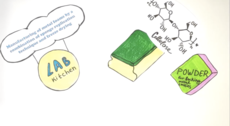M2.6 | Preparation and characterisation of cellular metals
Funding period: Jan 2018 to Mar 2022
Researcher: Alina Sutygina
Wrap-up
Keywords: Sponge replication technique, freeze-drying, aluminum, copper, lamellar pores
Background:
Open-cell metal foams, due to a combination of properties such as thermal/electrical conductivity and permeability to liquids and gases, have found applications in filters, heat exchangers, heat pumps, and substrates in catalysis, where foams often are coated with active materials such as MOFs or Zeolites, which, thanks to micropores in their structure, can absorb water and different gases. For these kinds of applications, the efficiency of a metal foam-based system depends strongly on parameters such as specific surface area, which influence the active-material loading onto the surface of metal foams.
There are many methods to manufacture open-cell metal foams. One of the ways to manufacture open-cell metal foams is the sponge replication technique. A distinctive feature of sponge replicated foams compared to other preparation methods (for example investment casting) is the hollow strut pores formed after template burn-out. These pores increase the specific surface area that is attractive for the above-mentioned applications but brings challenges for the coating process of the hollow struts with active materials.
A potential solution to access the inner strut surface can be a freeze and freeze-drying step including in the sponge replication process. That can also increase in addition the specific surface area by creating additional strut porosity. A combination of both techniques has been already successfully applied for the manufacturing of alumina (ceramic) foam, where the sponge replicated alumina foams after freezing and freeze-drying were characterized by many large pores, which significantly increased the specific surface area and strut porosity.
Despite the successful results of manufacturing ceramics foams by the sponge replication methods with additional freezing/freeze-drzing steps, this manufacturing route has never been applied to obtain metal foams.
Objective:
This work aims to develop manufacturing routes for porous open-cell metal foams by the sponge replication technique, where optimal thermal processing conditions for obtaining mechanically stable foams can be used for further manufacturing of foams with a combination of the sponge replication technique with freezing techniques to generate additional strut porosity keeping mechanical stability of metal foams. The final purpose of the work is to demonstrate the coating of both types of foams with active materials.
Methods:
Archimedes methods used for porosity; phase analysis XRD; morphology SEM; thickness of lamellar pores and material lamellae, specific surface area by µ-CT; compressive strength test; thermal conductivity by Hot Disk; specific surface area – BET analysis; water saturation.
Results:
The sponge replication technique combined with freezing/freeze-drying steps was used for the manufacturing of aluminum and copper foams. During thermal processing of metal foams temperature, atmosphere, powder loading, and cell size of the initial foam templates have been varied to manufacture mechanical stable metal foams with additional strut porosity.
Additional lamellar pores in strut foams have been generated during freeze and freeze-drying steps. The average thickness of them varied from 24 to 39 µm for aluminum foams and from 38 to 56 µm for copper foams. The obtained lamellar pores were improved access to the hollow struts pores and doubled the specific surface area for aluminum and copper foams with a cell size of foam templates of 20 ppi.
Metal foams foams have been coated with microporous active materials (SAPO-34 and HKUST-1) onto the surface of both types of foams. An active coating crystallized not only outside the strut surface but also in lamellar pores and hollow strut pores improving the active material loading.
Conclusions:
Successful manufacturing of aluminum and copper foams by the sponge replication technique combined with freezing/freeze-drying steps has been achieved, where generated additional lamellar pores increased an accesses to hollow struts and doubled the specific surface area. This manufacturing route can be adapted for other metals.
Originality:
This was the first time when metal foams were produced by the sponge replication technique combined with freezing/freeze-drying steps.








